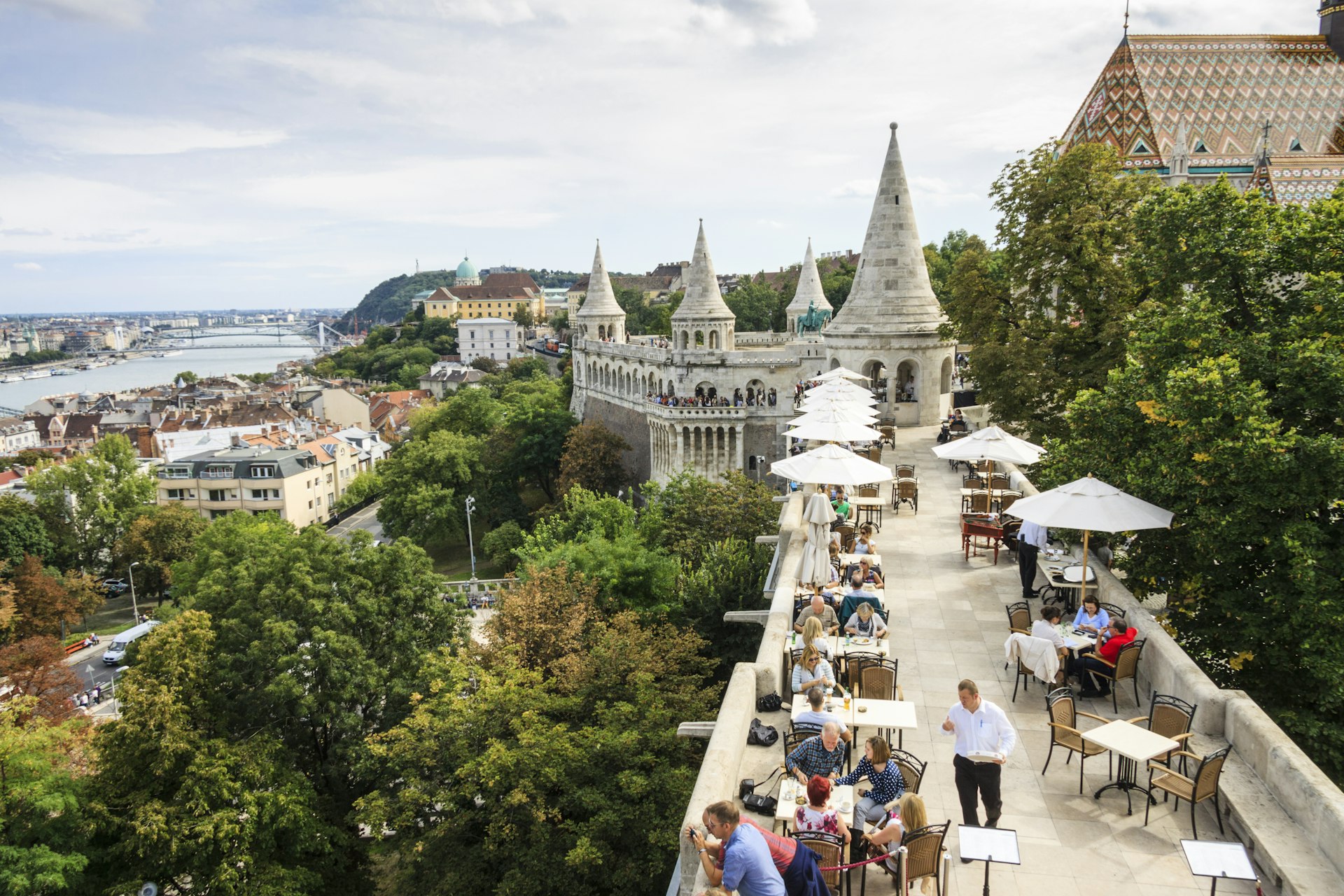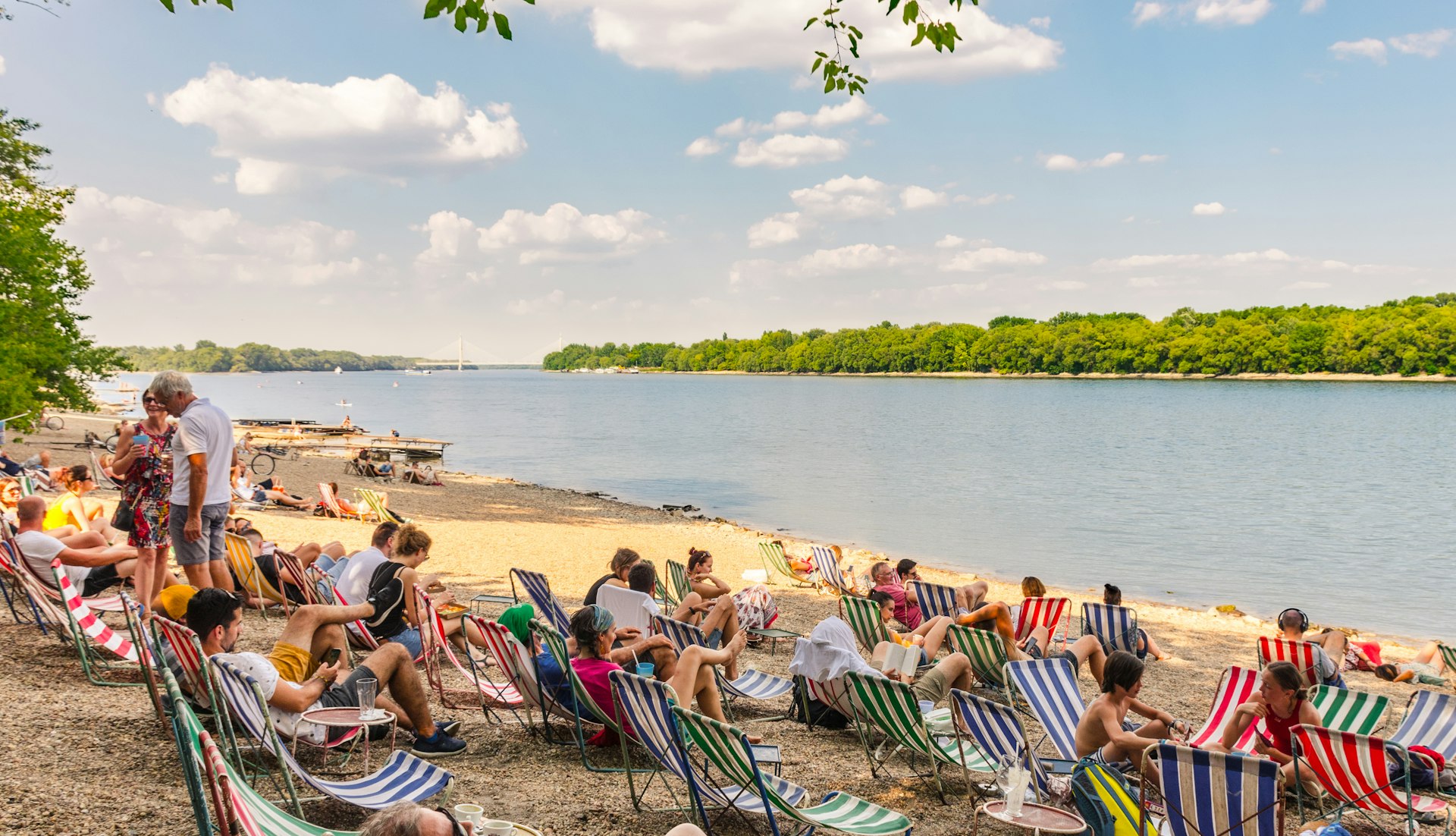With scorching hot summers and sub-zero temperatures in winter, Budapest shows a different face with each changing season.
City life spills outdoors into restaurant terraces, parks and even Danube beaches in the warmer months, while the colder, gloomy ones are more about culture and coziness. In between are the blossom-filled spring and the hiking-friendly months of fall.
No matter when you come, though, you’ll always find something to do in Budapest. If the weather is too damp for a hike through the Buda Hills, just head to a museum. When it’s too snowy for walking, jump into one of the city’s famous thermal baths. Here’s a guide to the best times to visit Budapest throughout the year.
High season is May to September and December
The warm summer from May to September is the time to come if you enjoy festivals. It’s also the peak season for tourism, bringing high temperatures and higher prices. The lively Sziget Festival, which takes place in August on Óbuda island, is perhaps the city’s most famous party, but you’ll find a full calendar of events running from spring to early fall.
Take your pick from the Jewish Art Days festival and Night of the Museums in the spring, Budapest Pride and the Formula 1 Grand Prix in the summer, and the Budapest Wine Festival in September as summer gives way to fall.
The other peak month is December, when Budapest’s atmospheric Christmas markets are in full swing. If you plan to visit during any of the high season months, be sure to book accommodations far in advance.
March, April and October are the best months to get outdoors
Budapest’s weather in spring and early fall is fresh and pleasant – you can still enjoy life outdoors, but as a bonus, you get to avoid both the scorching heat of summer and the high season crowds. Blossoming fruit trees add a pop of color to March and April in Budapest’s gorgeous gardens and parks. In the fall, rusty golden leaves make the hiking trails in the Buda Hills especially beautiful.
Visit in November, January and February to avoid the crowds
The months on either side of the winter festivities in Budapest are gray, cold and missing the joyful spirit you’ll find around Christmas. But there is an upside: if you’re looking to get a good deal on a hotel, this is definitely the right time to come. Budapest has plenty of museums and other indoor activities, plus concert halls, theaters, and an exciting nightlife and dining scene, so even if the weather is cold, you’ll still find plenty to do.
January quietens down after New Year’s Day
January is usually a quiet month, but it starts with a bang. The New Year’s Gala Concert at the Pesti Vigadó concert hall closes the festive holiday season and always draws a crowd. In mid-January in even-numbered years, you can head over to the Budapest International Circus Festival in City Park for an extravaganza of international and local circus acts and troupes, as well as performances from newcomers.
Key events: New Year’s Gala Concert, Budapest International Circus Festival.
Sights may reduce opening hours in February
In winter, some museums and tourist attractions cut their visiting hours short until the spring thaw, but you can fill your belly up at the Mangalica Festival in the public square of Szabadság tér for three days in mid-February. Mangalica is a unique, fluffy-coated breed of pig that produces pork with a particularly delicious taste, and you can try a variety of Mangalica sausages and salamis at the festival.
Key events: Mangalica Festival, Budapest Dance Festival.
Concert season starts in March
Budapest heads outside as spring begins to bloom, and the first blossom on the almond tree on Gellért Hill starts to appear on Budapest’s Instagram feeds. March also marks the start of the concert and theater season, while the VinCE wine show is a big event for oenophiles. A big national holiday takes place on March 15 to commemorate the 1848 Revolution.
Key events: VinCE Budapest, March 15 national holiday.
April is the perfect time for culture lovers to visit
Easter usually falls around the end of March or the beginning of April, and it’s observed with church visits and special foods in Budapest. This month also marks the beginning of the Budapest Spring Festival, one of the city’s largest and most important cultural events. Spread over 18 days, more than 200 events take place at multiple venues in the city. Culture-vultures will find the city especially vibrant at this time of year, with everything from opera and theater to classical concerts, jazz, world music and even contemporary circus shows.
Key events: Budapest Spring Festival, National Dance House Festival.

Celebrate Jewish culture in May
May plays host to the Jewish Art Days Festival, a two-week festival celebrating Jewish culture, food, theater and film. Beer lovers will want to come for Budapest Beer Week, where 60 Hungarian microbreweries team up with guest breweries from the Czech Republic and Germany in pubs, bars and other venues across the city.
Key events: Jewish Art Days Festival, Budapest Beer Week.
Museums stay open late on the solstice in June
Although June welcomes in the summer, it can be wet, with regular summer showers and storms. But that doesn’t stop the crowds coming out. To mark the summer solstice, many of Budapest’s museums open their doors from 6pm until the early morning hours for the Night of the Museums.
Key events: Danube Carnival, Night of the Museums.
July can be crowded with tourists
School ends for the summer holidays, and many locals head down to Lake Balaton to escape the heat, while international visitors crowd into Budapest. Plan your trip for the first weekend of July for Budapest Pride, with a week of LGBTIQ+ cultural events and parties, plus the famous annual Pride Parade.
Key event: Budapest Pride.

August is the city’s busiest month
If you’re traveling to Budapest in August, book accommodations, flights and event tickets well in advance – this is Budapest’s busiest month, with festivals and events galore. The Formula 1 Hungarian Grand Prix takes place in early August, and the Sziget Festival is in mid-August. Hungary’s biggest national holiday, St Stephen’s Day, comes on August 20 – be sure to watch the spectacular firework display from the Danube Banks.
Key events: Formula 1 Hungarian Grand Prix, Sziget Festival, St Stephen’s Day, Budapest Festival of Folk Arts
September has several events across the city
Warm weather lingers into September. It’s a pleasant month as the weather is bright but not too hot, and there are some great events going on around town. The Budapest Wine Festival in the Castle District has delicious Hungarian wines from around the country. Sip a glass while enjoying the amazing views.
Key events: Budapest Wine Festival, Jewish Cultural Festival.
October’s fall colors are stunning
With the fall colors, Budapest is beautiful in October. It’s a great time for hiking the Buda Hills, but there’s also a lot going on downtown. The Budapest Pálinka and Sausage Festival in the Castle District brings gastronomic offerings of potent fruit brandy and tasty local sausages, while CAFe Budapest celebrates the city’s contemporary art and design scene with various cultural events. October 23 is also an important national holiday commemorating the 1956 revolution.
Key events: Budapest Pálinka and Sausage Festival, CAFe Budapest, Design Week, Art Market Budapest, Mini Festival of Contemporary Music, October 23 national holiday.
November is a quiet time to visit
November begins with All Saints Day on November 1, a public holiday when Hungarians visit the graves of loved ones to leave candles and flowers. It’s a cold, gray month, and November is a quiet time in the city before the advent festivities begin for Christmas.
Key event: All Saints Day.
December is packed with Christmas festivities
In the weeks leading up to Christmas, Budapest bursts into life with twinkling Christmas lights, buzzing markets and all kinds of festive celebrations. Wander through town with a cup of mulled wine and munch the freshly roasted chestnuts sold at market stalls dotted around the streets. You can also sample delicious “chimney cake,” a brioche-like treat grilled over hot coals and rolled in nuts, cinnamon or cocoa.
Key events: Christmas markets, New Year’s Eve and Gala Ball.
